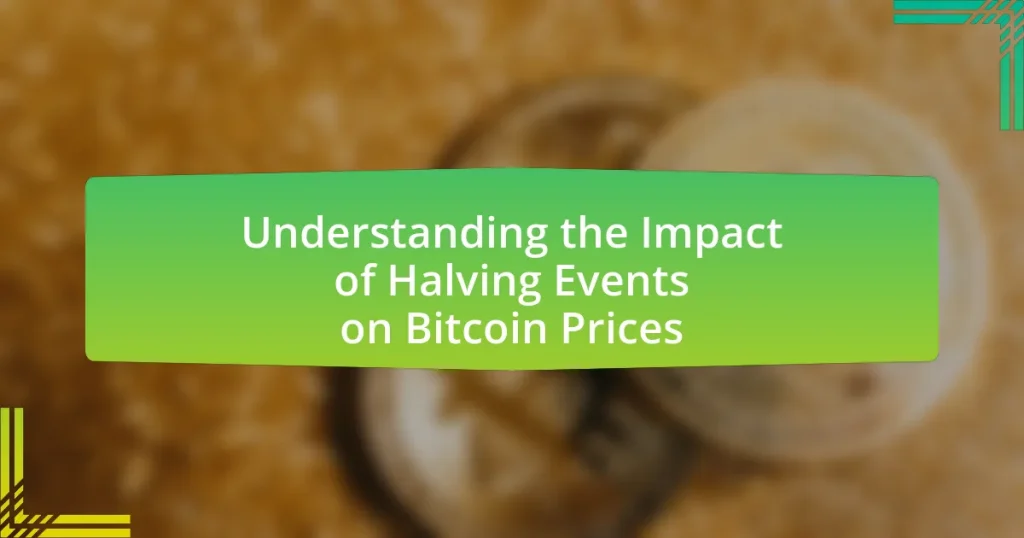Halving events in Bitcoin are programmed occurrences that reduce the mining reward for new blocks by half, occurring approximately every four years. This mechanism is crucial for controlling inflation and ensuring a finite supply of 21 million bitcoins. The article explores how halving events impact Bitcoin’s supply, price movements, and miner incentives, highlighting historical trends that show significant price increases following each halving. Additionally, it discusses the influence of market sentiment, macroeconomic conditions, and practical strategies for investors to navigate the volatility surrounding these events.

What are Halving Events in Bitcoin?
Halving events in Bitcoin are programmed occurrences that reduce the reward for mining new blocks by half, occurring approximately every four years or after every 210,000 blocks mined. This mechanism is integral to Bitcoin’s monetary policy, designed to control inflation and ensure a finite supply of 21 million bitcoins. The first halving took place in 2012, reducing the block reward from 50 to 25 bitcoins, followed by subsequent halvings in 2016 and 2020, which further decreased the rewards to 12.5 and 6.25 bitcoins, respectively. These events are significant as they historically correlate with price increases due to reduced supply and heightened demand, influencing market dynamics.
How do Halving Events affect Bitcoin’s supply?
Halving events reduce the rate at which new bitcoins are created, directly impacting Bitcoin’s supply. Specifically, every four years, the reward for mining new blocks is halved, which decreases the number of new bitcoins entering circulation. For instance, the first halving in 2012 reduced the block reward from 50 to 25 bitcoins, and the most recent halving in May 2020 cut it from 12.5 to 6.25 bitcoins. This reduction in supply, while demand remains constant or increases, historically leads to upward pressure on Bitcoin’s price due to scarcity.
What is the mechanism behind Bitcoin’s halving process?
Bitcoin’s halving process occurs approximately every four years, reducing the reward for mining new blocks by half. This mechanism is built into Bitcoin’s code to control the supply of the cryptocurrency, ensuring that the total supply will never exceed 21 million coins. The halving event decreases the rate at which new bitcoins are generated, which historically has led to increased scarcity and often correlates with price increases due to heightened demand. For instance, the first halving in 2012 reduced the block reward from 50 to 25 bitcoins, and subsequent halvings in 2016 and 2020 further reduced it to 12.5 and 6.25 bitcoins, respectively. These events have consistently influenced market dynamics, demonstrating the significant impact of halving on Bitcoin’s price trajectory.
How often do Halving Events occur in Bitcoin?
Halving events in Bitcoin occur approximately every four years. Specifically, these events take place after every 210,000 blocks are mined. The first halving occurred in November 2012, the second in July 2016, and the third in May 2020, demonstrating the consistent four-year cycle. This schedule is built into Bitcoin’s code to control inflation and reduce the rate at which new bitcoins are created.
Why are Halving Events significant for Bitcoin?
Halving events are significant for Bitcoin because they reduce the rate at which new bitcoins are created, effectively decreasing the supply of new coins entering the market. This reduction in supply, occurring approximately every four years, historically leads to increased demand and higher prices, as seen in previous halving events in 2012, 2016, and 2020, where Bitcoin’s price surged significantly in the months following each event. The economic principle of supply and demand supports this trend, as a lower supply with steady or increasing demand typically results in price appreciation.
What historical trends have emerged from past Halving Events?
Historical trends from past Halving Events indicate a consistent pattern of significant price increases in Bitcoin following each event. Specifically, after the first Halving in November 2012, Bitcoin’s price rose from approximately $12 to over $1,100 within a year. The second Halving in July 2016 saw Bitcoin’s price increase from around $650 to nearly $20,000 by December 2017. The most recent Halving in May 2020 led to a price surge from about $8,500 to an all-time high of approximately $64,000 in April 2021. These trends suggest that Halving Events create a supply shock, reducing the rate of new Bitcoin creation, which historically correlates with upward price momentum in the months and years following each Halving.
How do Halving Events influence miner incentives?
Halving events reduce the block reward miners receive for validating transactions, directly impacting their incentives. When a halving occurs, the reward decreases by 50%, which can lead to decreased profitability for miners if the price of Bitcoin does not increase correspondingly. Historical data shows that after previous halvings, such as in 2012 and 2016, Bitcoin’s price often increased significantly, incentivizing miners to continue operations despite lower rewards. This relationship between halving events and price increases creates a cycle where miners are motivated to maintain their activities in anticipation of future price rises, thus influencing their overall incentives in the network.

How do Halving Events impact Bitcoin Prices?
Halving events significantly impact Bitcoin prices by reducing the rate at which new bitcoins are created, leading to increased scarcity. Historically, after each halving event, Bitcoin has experienced substantial price increases; for instance, following the 2012 halving, Bitcoin’s price rose from around $12 to over $1,100 within a year. Similarly, after the 2016 halving, the price surged from approximately $650 to nearly $20,000 by the end of 2017. These price movements are often attributed to the supply-demand dynamics, where reduced supply, coupled with sustained or increasing demand, drives prices higher.
What is the relationship between Halving Events and Bitcoin price movements?
Halving events significantly influence Bitcoin price movements by reducing the rate at which new bitcoins are created, thereby decreasing supply. Historical data shows that after each halving event in 2012, 2016, and 2020, Bitcoin’s price experienced substantial increases, often reaching new all-time highs within a year following the event. For instance, after the 2012 halving, Bitcoin’s price rose from approximately $12 to over $1,100 within a year. Similarly, following the 2016 halving, the price surged from around $650 to nearly $20,000 by the end of 2017. These patterns suggest a correlation between halving events and subsequent price appreciation, driven by the principles of supply and demand in the cryptocurrency market.
How have Bitcoin prices reacted to previous Halving Events?
Bitcoin prices have historically experienced significant increases following Halving Events. For instance, after the first Halving in November 2012, Bitcoin’s price rose from approximately $12 to over $1,100 within a year. Similarly, following the second Halving in July 2016, the price surged from around $650 to nearly $20,000 by December 2017. The most recent Halving in May 2020 saw Bitcoin’s price increase from about $8,500 to an all-time high of over $64,000 by April 2021. These patterns indicate a trend of substantial price appreciation in the months and years following each Halving Event.
What role does market sentiment play during Halving Events?
Market sentiment significantly influences price movements during Halving Events. When a Halving occurs, the reduction in Bitcoin’s supply often leads to heightened investor optimism, driving demand and subsequently increasing prices. Historical data shows that following past Halving Events in 2012 and 2016, Bitcoin experienced substantial price rallies, attributed largely to positive market sentiment and speculative trading. For instance, after the 2016 Halving, Bitcoin’s price surged from around $450 to nearly $20,000 within a year, demonstrating the strong correlation between market sentiment and price dynamics during these events.
Why do investors pay attention to Halving Events?
Investors pay attention to Halving Events because these events historically lead to significant price increases in Bitcoin. Halving Events reduce the block reward for mining Bitcoin by 50%, which decreases the rate of new Bitcoin supply entering the market. For instance, after the 2012 halving, Bitcoin’s price rose from around $12 to over $1,100 within a year. Similarly, following the 2016 halving, the price surged from approximately $650 to nearly $20,000 by the end of 2017. This pattern suggests that reduced supply, combined with consistent or increasing demand, tends to drive prices higher, making Halving Events critical indicators for investors.
What strategies do traders use around Halving Events?
Traders commonly employ strategies such as accumulation, speculation, and hedging around Halving Events. Accumulation involves buying Bitcoin in anticipation of price increases following the halving, as historical data shows that prices often rise significantly post-event; for instance, after the 2012 and 2016 halvings, Bitcoin prices surged by over 800% and 1,000%, respectively, within a year. Speculation focuses on short-term trading around the event, capitalizing on volatility; traders often use technical analysis to identify entry and exit points. Hedging strategies may involve options or futures contracts to mitigate risks associated with price fluctuations during this period. These strategies are informed by historical trends and market behavior observed during previous halving events.
How do Halving Events affect long-term investment perspectives?
Halving events significantly influence long-term investment perspectives by reducing the rate at which new bitcoins are created, thereby tightening supply. This reduction in supply, historically, has led to increased demand and higher prices over time. For instance, after the halving events in 2012 and 2016, Bitcoin’s price surged dramatically in the following months and years, with the price reaching approximately $20,000 in late 2017 and around $64,000 in April 2021. These historical trends suggest that investors often anticipate price increases post-halving, leading to a bullish sentiment that can drive long-term investment strategies.

What are the potential future implications of Halving Events on Bitcoin prices?
Halving Events are expected to lead to increased Bitcoin prices due to the reduction in the rate of new Bitcoin supply. Historically, after each halving, Bitcoin has experienced significant price appreciation; for instance, after the 2012 halving, Bitcoin’s price rose from approximately $12 to over $1,100 within a year. Similarly, following the 2016 halving, the price surged from around $650 to nearly $20,000 by the end of 2017. These patterns suggest that the market anticipates future scarcity, driving demand and consequently prices higher.
How might upcoming Halving Events shape market expectations?
Upcoming Halving Events are likely to shape market expectations by creating anticipation for reduced Bitcoin supply, which historically correlates with price increases. For instance, previous halvings in 2012, 2016, and 2020 led to significant price surges in the months following the events, as the reduction in new Bitcoin issuance heightened demand among investors. This pattern suggests that market participants may begin to accumulate Bitcoin in advance of the halving, driving prices upward due to perceived scarcity. Additionally, the media coverage and community discussions surrounding these events often amplify bullish sentiment, further influencing market behavior.
What factors could influence Bitcoin prices post-Halving?
Bitcoin prices post-Halving can be influenced by several key factors, including supply reduction, market demand, investor sentiment, regulatory developments, and macroeconomic conditions. The supply reduction occurs because Halving events cut the block reward miners receive by half, which historically has led to increased scarcity. For instance, after the 2016 Halving, Bitcoin’s price rose from around $450 to nearly $20,000 by the end of 2017, demonstrating the impact of reduced supply on price.
Market demand plays a crucial role as increased interest from retail and institutional investors can drive prices higher. Positive investor sentiment, often fueled by media coverage and social media trends, can also lead to price surges. Regulatory developments, such as favorable legislation or increased scrutiny, can either bolster or hinder market confidence, affecting prices accordingly. Lastly, macroeconomic conditions, including inflation rates and global economic stability, can influence investor behavior and, consequently, Bitcoin prices.
How do macroeconomic conditions affect the impact of Halving Events?
Macroeconomic conditions significantly influence the impact of Halving Events on Bitcoin prices. During periods of economic uncertainty or inflation, investors often seek alternative assets like Bitcoin, which can lead to increased demand and higher prices following a Halving Event. For instance, the 2020 Halving occurred amidst the COVID-19 pandemic, which resulted in unprecedented monetary stimulus and heightened interest in cryptocurrencies as a hedge against inflation, contributing to Bitcoin’s price surge to an all-time high of nearly $64,000 in April 2021. Conversely, in a stable economic environment with low inflation, the price impact of Halving Events may be muted, as investors may not prioritize Bitcoin over traditional assets. Thus, macroeconomic factors such as inflation rates, monetary policy, and overall market sentiment play a crucial role in shaping the market’s reaction to Halving Events.
What practical strategies can investors adopt regarding Halving Events?
Investors can adopt several practical strategies regarding Halving Events to optimize their positions in Bitcoin. One effective strategy is to accumulate Bitcoin before the halving, as historical data shows that prices often rise in anticipation of reduced supply; for instance, the 2020 halving saw Bitcoin’s price increase from around $8,000 to over $60,000 within a year. Another strategy is to implement a dollar-cost averaging approach, allowing investors to buy Bitcoin at regular intervals, which can mitigate the impact of volatility surrounding the halving. Additionally, investors should consider setting stop-loss orders to protect against sudden price drops post-halving, as market reactions can be unpredictable. Finally, staying informed about market sentiment and trends can help investors make timely decisions, as seen in previous halving cycles where community sentiment influenced price movements significantly.
How can investors prepare for price volatility during Halving Events?
Investors can prepare for price volatility during Halving Events by implementing risk management strategies, diversifying their portfolios, and staying informed about market trends. Risk management strategies, such as setting stop-loss orders, help limit potential losses during sudden price swings. Diversification across different cryptocurrencies or asset classes can mitigate the impact of volatility specific to Bitcoin. Historical data shows that Halving Events, like those in 2012, 2016, and 2020, often lead to significant price fluctuations, making it crucial for investors to remain vigilant and adaptable to changing market conditions.
What are the best practices for investing in Bitcoin around Halving Events?
The best practices for investing in Bitcoin around Halving Events include conducting thorough research, timing investments strategically, and diversifying portfolios. Investors should analyze historical price trends, as Bitcoin has historically experienced price increases following halving events; for instance, the 2012 and 2016 halvings preceded significant price surges. Timing investments to enter before the halving can capitalize on potential price appreciation, while diversifying into other cryptocurrencies or assets can mitigate risks associated with volatility. Additionally, maintaining a long-term perspective is crucial, as immediate price fluctuations may not reflect the overall trend post-halving.






